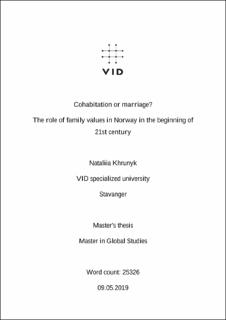| dc.description.abstract | Cohabitation has become a normal phenomenon among Norwegians. It may be seen as a transition before dating and marrying, but it may also be a choice of living together as a family. But even if it is widely accepted, many young Norwegians do see marriage as the highest step in relationships.
Marriage is regarded as the most committed type of union formation, whereas cohabitation is seen as less stable (Wiik, 2010, p. 51). That is why marriage may bring extra security for the family relationships. Parenthood out of wedlock has been increasing in Norway. However, many young couples get married short after they become parents. In my thesis, I also describe why people choose different timing for such big events.
Changes like increasing divorce rates, law fertility rates, greater women participation in labor market, growing amount of children born outside marriage may have different explanations. Development of gender equality is of a great factor here. Both men and women are in the process of finding balance between work and family (Esping-Andersen & Billari, 2015, pp. 6-9). Growing individualization leads to more independent choices in private lives of individuals (Wiik, Bernhardt & Noack, 2010, pp. 272-273). As a result, detraditionalization leads to reconstructing older traditions (Ellingsæter, 2018, p. 263). Marriage, in this context, preserves some of its symbolic values, which lack in cohabitation (Wiik, 2010, p.51).
Recent trends that may be observed in Norway may also find the explanation in the Second Demographic Transition process (Lesthaeghe, 2011, pp. 179-218). However, a reversal may be possible. In case of achieving egalitarian relationships based on mutual understanding, a new equilibrium of stable family life may be the outcome (Esping-Andersen & Billari, 2015, pp. 24-25). | en_US |
